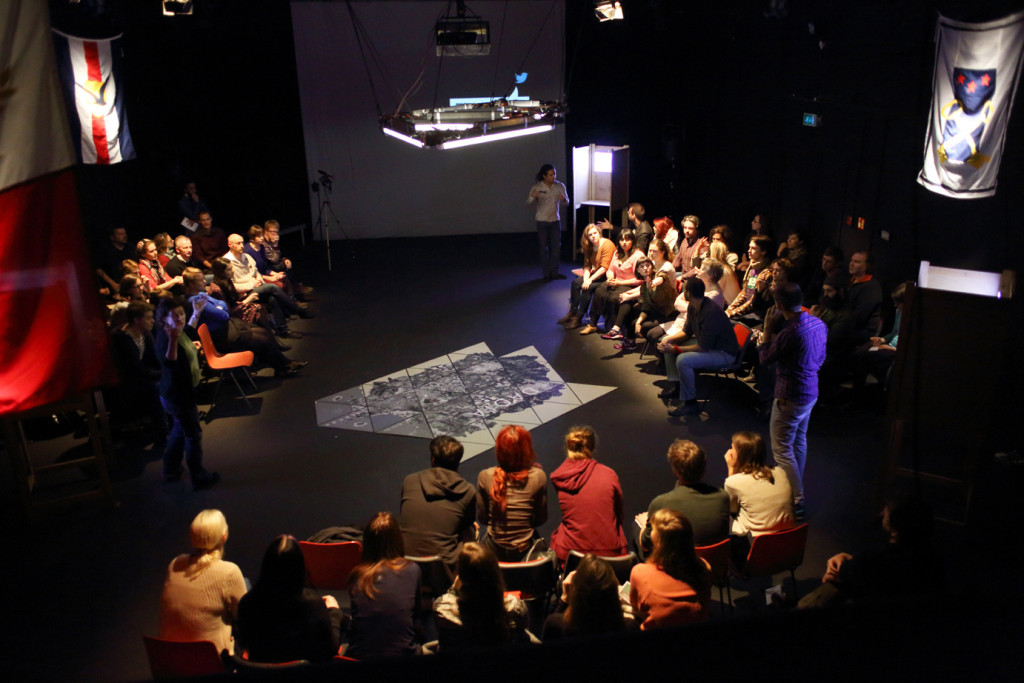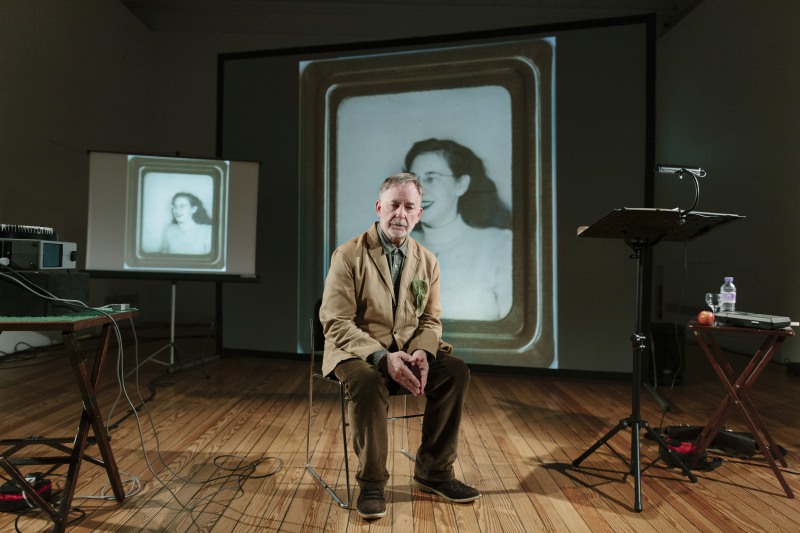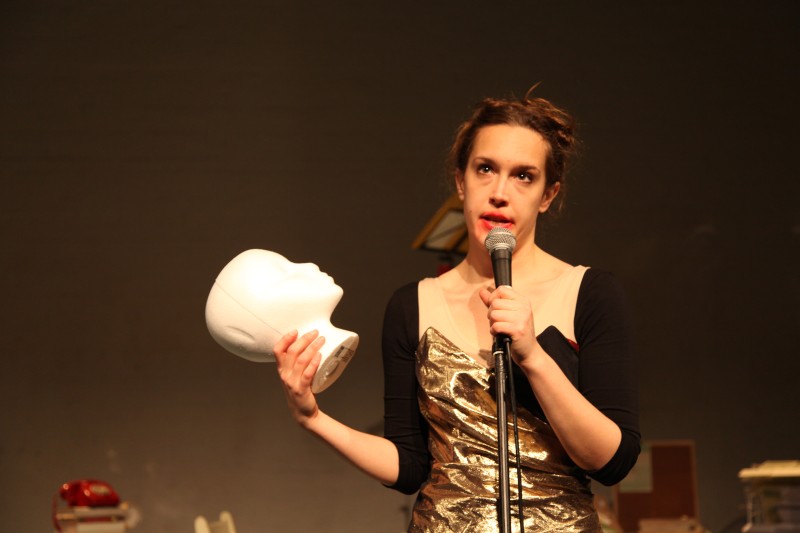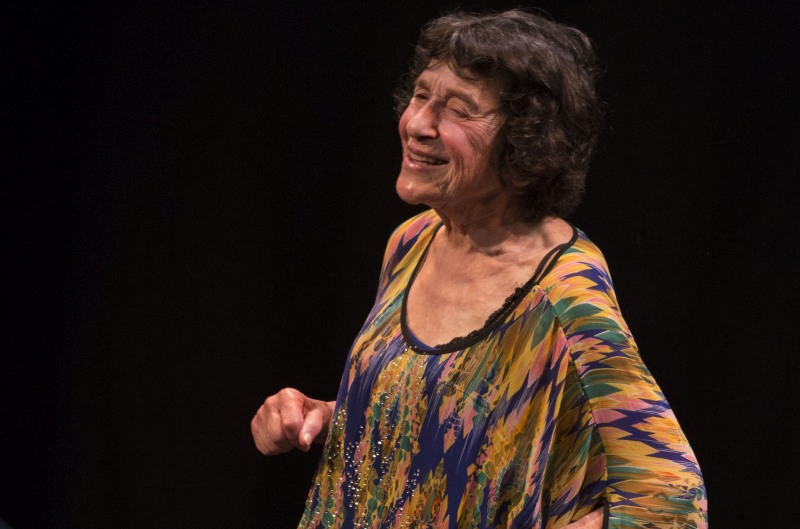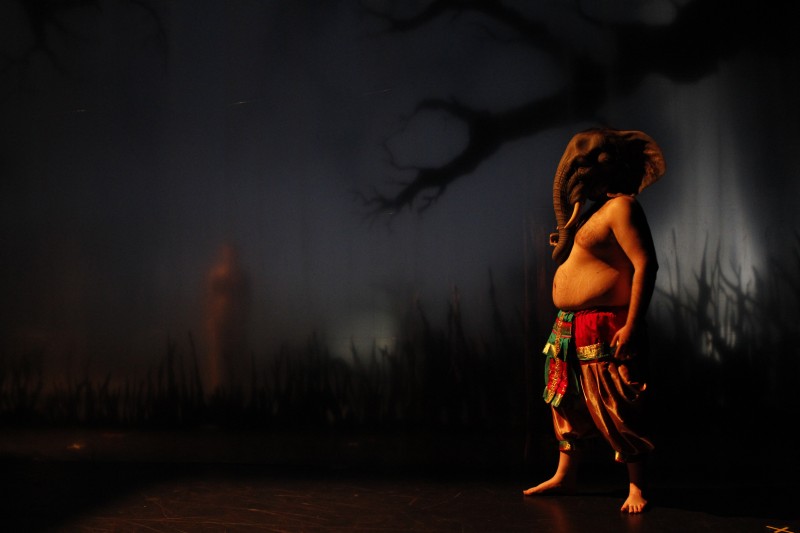Coney’s Early Days (of a better nation) – inspired by the 2011 UK riots, the Arab spring, Iceland’s crowd-sourced constitution, and the rise (and fall) of Occupy – is set in a TV studio/balloting station/European Congress meeting hall and it is participatory. Coney propose ‘to put the audience at the heart of their work’; ‘to blur the boundaries between performance and real-life choices’; and to ask the bold question ‘can a piece of immersive theatre change people’s minds about politics?’ It promises to be an inspiring evening.
While I am in the foyer an excited and bemused usher gives me a postcard with a message addressing me as ‘Dear Child’ Disconcertingly he signals that he is giving a different card to my colleague. We are to be split up. He explains that we will all be met in the large hall before we are split up; that the actors will move us to other rooms; and that we will know more when we get in there. Then he confesses in a tone that suggests this kind of show is a tricky one to usher, ‘It’s all a bit last minute; we’re not quite sure how it works.’ Is he unknowingly breaking some rules and giving the game away? Is he unfamiliar with playing outside the black box, or is he in on the act? I hope it is the latter. So here I am on the threshold of meaningful engagement at the first stage of induction looking for clues; searching for meaning in anything and everything, even in the theatre foyer. I am a willing participant.
We are split up. In the small group I’m in, I am told I am part of the war ravaged fictitious country of Dacia. A dictatorship has just been overthrown and we as a group are to take part in rebuilding the nation. To do this we are prescribed the role of city people, islanders or plains people. Each group has different concerns and experiences of the war. My group is the city group, the short straw, the smallest group with a strong leader who it seems has had something to do with overthrowing the dictator, but was also part of the dictatorship, somehow. She is at pains to be inclusive and some of us are already dreading that ‘what do you think?’ moment. We are temporarily let off the hook while we watch the telly. Then, back to the interrogation of the task. I feel like I am in school having not done my homework, and now I am quite hot under the collar. Let the rest of the class answer the teacher’s questions, I think to myself. I feel stress for the actor/facilitator and responsible for not wrecking her game. But this only adds to my inability to go any way towards caring about Dacia and its dilemma. I tell myself it is only a game. The awkward group work over, we move back to the bigger group of audience/participants and I am relieved that there are more people to sort this thing out.
The theatre setting and design for this part is visually and aurally impressive. We are sat on three sides with a large screen upstage, which is used to punctuate the events with reports, messages and updates. Each group sits under the appropriate banner. We are like the United Nations. I begin to feel thrilled. Facilitated by actors in role/character in each group, together with some apparent company plants and supporters who are definitely in on the act, we are confidently steered through almost two hours of negotiations punctuated by theatrical moments that are reminiscent of the TV’s previous night’s coverage of the election. Then curiously, breaking the spell, we are given an interval and encouraged to get a drink at the bar, as one does at the theatre. Herein lies a problem.
Coney have prepared a tightly stage-managed numbers game that controls our groupings, our storylines, the limited time we have to do the tasks, the coin we are eventually given to spend rebuilding the nation and, to a considerable extent, our thinking processes, thus limiting the freedom thoughtful democratic decision-making can offer. All this is in the service of a gameplay that has to be performed according the rules set, and which within the time constraints cannot possibly facilitate deep engagement. The time slot that conventional theatre scheduling allows frustrates this piece to some extent. This all throws up curious behaviour that is a mixture of play-acting, playing up to the gallery, and what seems to be some brave attempts to stop the clock. Several audience members are clearly up for the game and enjoying the sport, egged on by facilitators – I feel my thrill draining away.
Throwing caution to the wind and really allowing your audience free rein may sometimes require the actor to pay attention to where the participants may wish to go or some deeper listening to the questions they are asking, as opposed to expecting them to simply go along with the actor in order to make it work for the scenario. There was a moment within the first round of whole-group negotiations when a genuine and crucial question coming from one of the islander/participants was overlooked and appeared to be trampled on by the actor/facilitators. It was a moment that, had it been fully engaged with, may well have steered the activity in a more imaginative and perhaps, for the piece, unexplored direction.
It is this not being in the moment, this getting on with it, that is in danger of not raising the stakes of the gameplay to much more than the murder mystery experience where everyone has a really good laugh at themselves in role, and a nice drink halfway through. I felt odd with my plastic cup of wine when supposedly we were starving to death.
To return to the company’s own question: can a piece of immersive theatre change people’s minds about politics? When education and theatre are more explicitly integrated in a radical applied context, maybe it can and maybe it does.

